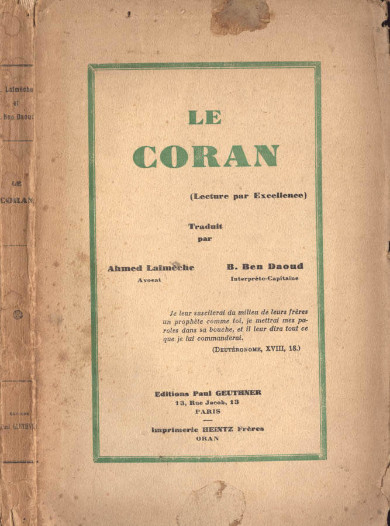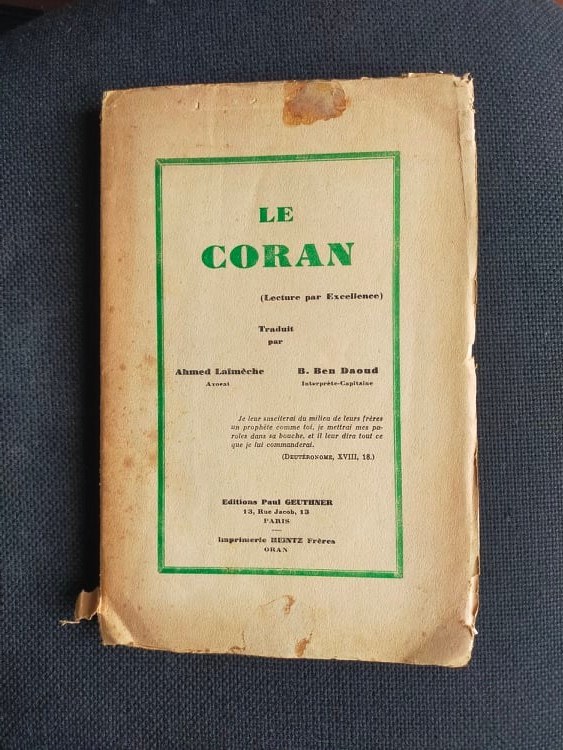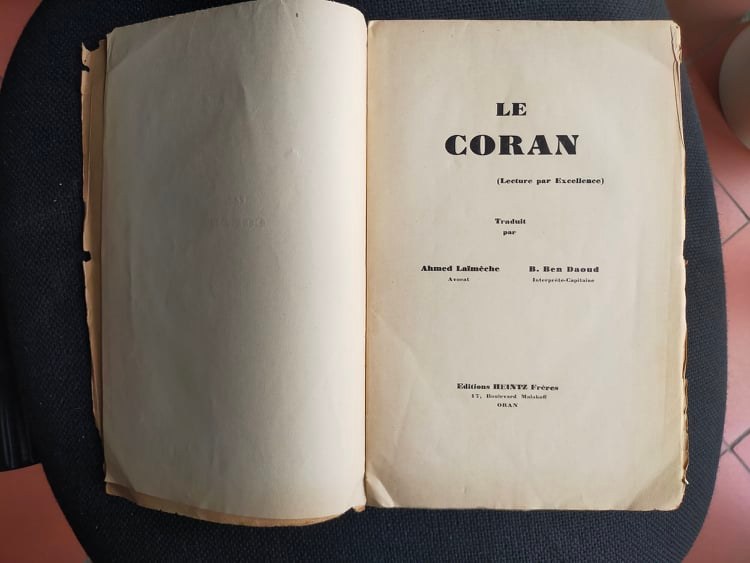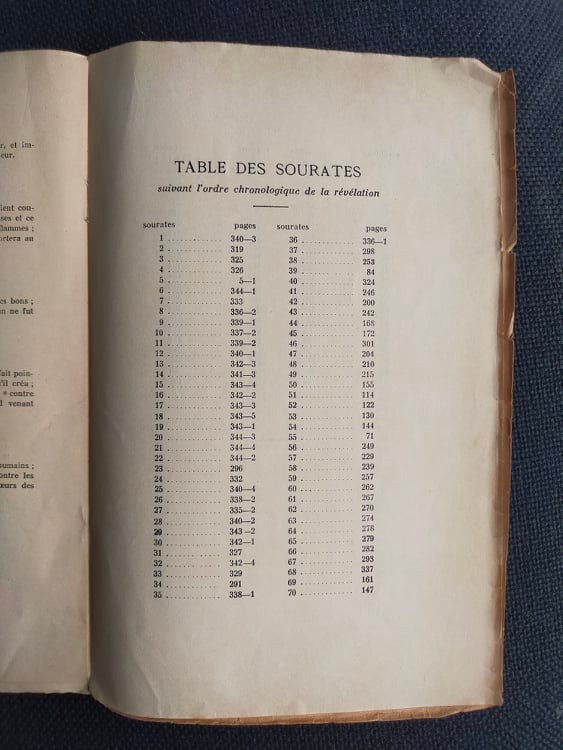This week, we present the first Muslim Qur’an translation into French, after having discussed its English equivalent last week. Both efforts had their origin in the colonial period, but there were notable differences between the contexts of the French-ruled Maghreb and British India. Before addressing them, let us take a closer look at ‘Le Coran,’ which was translated by two Muslims from Oran, Algeria, Ahmed Laïmèche and Benaouda Ben Daoud.
Laïmèche was both an Islamic scholar and a lawyer at the appeals court of Algiers. He was twice denied a position at the madrasa of Algiers because of his alleged anti-French political leanings and because his activity as a lawyer was not in line with the quietist, apolitical attitude the French authorities expected from a Muslim scholar. Despite this, Laïmèche finally obtained a position teaching Islamic law at the madrasa of Tlemcen and published a two-volume translation of Ibn Rushd’s Bidāya, a manual for jurists, between 1926 and 1928. After he was dismissed from his chair in 1928, probably for the same reasons for which the French authorities had considered him suspect to begin with, he settled in Oran as a lawyer and teamed up with Benaouda Ben Daoud, an army interpreter, to translate the Qur’an into French.
Their joint translation was published by Paul Geuthner in Paris and printed by Heintz Frères in Oran. It is not dated but two short reviews appeared in academic journals, the Revue Biblique and the Journal of the Royal Asiatic Society, in January 1932, and according to the Revue Biblique, their review copy was sent to them in July 1931. The Revue Biblique gave the translation credit for its good literary style and readability. The reviewer for the Journal of the Royal Asiatic Society, R. Levy, called it ‘fairly made though without distinction’ and mentioned, in an implicitly disparaging way, the demonstration of the translators’ faith on the cover: First, they added to the dry French title ‘Le Coran’ a translation of the Arabic word ‘Qurʾān’ as ‘lecture par excellence’ (‘the preeminent reading’). Second, they quoted Deuteronomy 18:18: ‘I will raise up for them a prophet like you from among their brethren, and I will put my words in his mouth, and he will tell them everything I command him.’ This verse is often understood by Muslims as a reference to Muḥammad and quoted as evidence that the Bible predicted his mission.
From the fact that the authors sent review copies to academic journals it is clear that they did not exclusively address a Muslim audience and that they were hoping to receive some recognition in Europe. This is also evident from their use of the Flügel edition of the Qur’an (Leipzig 1834), which was widespread in Europe but hardly the standard Qur’an used by Muslims in the Maghreb. Laïmèche and Ben Daoud follow Flügel’s eclectic choice of Qur’anic reading traditions (qirāʾāt) as well as his idiosyncratic verse numbering system. The adoption of the Flügel edition and the fact that the translators did not include the Arabic text of the Qur’an would have made the use of their translation impractical for Muslims who were aiming to align the French text with the Arabic source text.
The translation is, on the whole, fairly close to the source text. For example, Q 3:7 calls certain verses mutashābihāt, which translators render in various ways, including ‘figurative,’ ‘allegorical,’ ‘giving rise to doubt,’ ‘sowing confusion’ or ‘being susceptible to different interpretations.’ Laïmèche and Ben Daoud render it literally as ‘resembling each other’ (‘qui entre eux se ressemblent’), without offering an interpretation. They generally refrain from providing interpolations, commentary or notes, from specifying the persons or objects that pronouns refer to or otherwise explaining the text, unlike, for example, Kazimirski’s popular Qur’an translation (first published in 1840) which they seem to have consulted. There is no introduction and no index either. The only material the book contains in addition to the translation is a list of suras in their canonical order and, more interestingly, a table of the chronology of suras that seems to be based on the Cairo edition of the Qur’an, which is the only indication that they might have had access to a Qur’an edition from the Muslim world.
Despite the translators’ reluctance to add interpretive content, the reviewers were critical of what they deemed excessive interpretive interventions, or a lack of precision, on the part of the translators. The Revue Biblique disapproves of some choices in the translation of the Fātiḥa (Q 1) and negatively contrasts Laïmèche and Ben Daoud’s version with the ‘familiar’ translation of this sura, which bears great similarity to Kazimirski’s translation. For example, the reviewer wants to see the Basmala (bi-smi llāh al-raḥmān al-raḥīm) translated as ‘Au nom de Dieu clément et miséricordieux’ (‘In the name of God, clement and merciful’) while Laïmèche and Ben Daoud render it as ‘Au nom du Dieu de bonté et de miséricorde’ (‘In the name of the God of goodness and mercy’). This is most likely a conscious literary and theological choice, rather than an inexpert translation as implied by the reviewer, who was obviously expecting a ‘familiar’ rendering of the text.
The reviewer for the Journal of the Royal Asiatic Society, the aforementioned R. Levy, critically mentions several instances in which the translators chose not to use the most literal meaning of a Qur’anic term, probably to enhance readability. He also points to a verse where the translators made an unmarked interpolation: in Q 10:2, they render alladhīna āmanū (‘those who believe/have believed’) as ‘croyants qui font des bonnes oeuvres’ (‘believers who do good deeds’). This could be a theological statement about faith (īmān), but since the translators do not use the same interpolation in other verses with a similar wording, it is probably merely a mix-up or mistake in an otherwise fairly respectable translation. It seems likely that a certain amount of anti-Muslim bias governed the reserved reception and subsequent marginalization of this work in the French-speaking world.
If we broaden our perspective and compare the emergence of Muslim Qur’an translations in colonial France to the context of the British Empire, the difference is striking. By the late 1930s, there were at least three Muslim Qur’an translations into English that were extremely successful, and quite a few more that were less popular. The first Muslim Qur’an translation into English was published in 1905, more than 25 years before Laïmèche and Ben Daoud’s work appeared, and translation activity in British India was far more intense than in the French-ruled Maghreb. The fact that the Muslim population of British India was by far the larger one obviously plays a role here, but of even bigger importance might be the fact that in the early twentieth century, India already had a strong tradition of Qur’an translation that went back at least to Shāh Walī Allāh (1703–1762). Moreover, since the first half of the nineteenth century, the printing press had spread all over India and scores of publishing houses in many cities on the subcontinent printed the Arabic Qur’an as well as translations into local languages. Thus, there was a market for such works, there were companies willing and able to publish them and customers who were interested in buying and using them. By contrast, despite the existence of a substantial number of Amazigh (‘Berber’) Muslims in the Maghreb whose first language was not Arabic, there was no local tradition of Qur’an translation, and in 1931 Muslim scholars in the larger region, especially the religious centers in Cairo and Istanbul, were only just starting to get over their reservations against the very idea of translating the Qur’an. Muslim-owned printing presses were probably also in short supply to the west of Egypt. Ironically, when Laïmèche and Ben Daoud were looking for a suitable publisher, they ended up with a Paris-based publisher that was specialized in ‘Orientalia’ and a local Algerian printer whose portfolio included everything from school books and Catholic catechisms to literature on ‘the colonies.’
There were also no wealthy Muslim donors, missionary networks or large organized communities of Muslims of the kind that many South Asian Qur’an translators could rely on for the funding and distribution of their works, such as the wealthy ruler (nizam) of Hyderabad, the Ahmadiyya movement or the Twelver Shi’i community that was active in Northern India. The international networks that had their center in South Asia only connected with the French field in 1959 when Muhammad Hamidullah, an Indian from Hyderabad, published his translation, the first bilingual work on the French market, which proved to be a lasting success. In the absence of transnational networks and substantial funding, with a monolingual French translation that did not satisfy the religious needs of practicing Muslims, and facing an academic field that took a disparaging view of the efforts of believing Muslims, Laïmèche and Ben Daoud probably had no chance of achieving a similar success, especially at a time in which secularism was the dominant ideology both in France and in the former center of the Ottoman Empire, Istanbul. Nevertheless, their Qur’an translation, produced in the context of colonial Algeria, was an important milestone of Muslim self-assertion in the language of empire.
Johanna Pink






